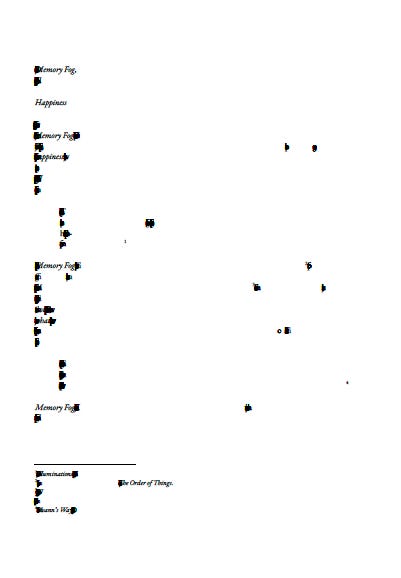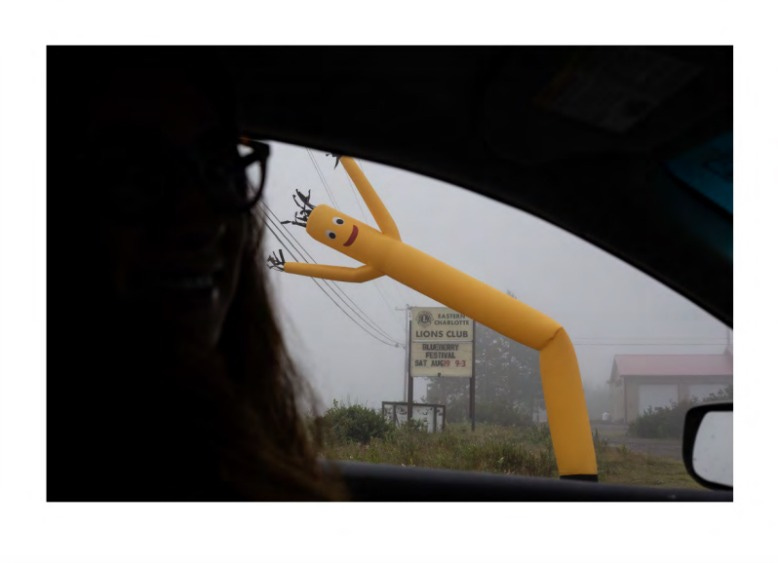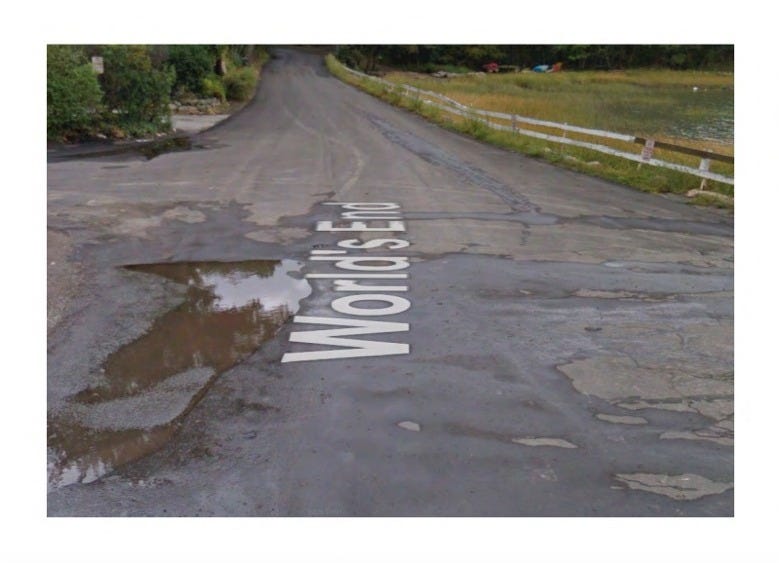On Memory Fog
Happiness | Acceleration and Locale I | Aside on fog | Epigraphic injections
The following was also published as the introduction to Memory Fog by Dimitri Karakostas (NDA Books, 2025), which you can order at memoryfog.bigcartel.com.
Happiness
For the past week, I have been waking up every morning and immediately opening, sometimes in order, sometimes discontinuously, the four volumes of Memory Fog, Dimitri Karakostas’ new photo book.
The very first thing that one sees, and not only because of the apt title, is that these photos engage with the problem of memory. But, I think they do so via a certain notion of happiness (this is always surprising).
In “The Image of Proust”, Walter Benjamin makes a similar claim, naming two types, or moments, of happiness: the hymnic and the elegiac.
The one is the unheard-of, the unprecedented, the height of bliss; the other, the eternal repetition, the eternal restoration of the original, the first happiness. It is this elegiac idea of happiness—it could also be called Eleatic—which for Proust transforms existence into a preserve of memory.1
This elegiac happiness is the kind which also haunts Memory Fog. The sympathetic repetition of images (in the medieval sense) affects us almost instantly.
Memory and with it any potential for happiness in its non-hymnic2 form becomes radically external. This idea is endlessly thrilling and somewhat frightening: happiness, against the usual conventional wisdom, is not to be found “within.” Or, maybe a better way to phrase it: if happiness is within, we never know exactly what it is within; we can never be sure what or how the latent happiness within us will ring in sympathy with some externality that for a moment we will also become. This is the dark otherside of elegiac happiness.
The past is hidden outside the realm of our intelligence and beyond its reach, in some material object (in the sensation that this material object would give us) which we do not suspect. It depends on chance whether we encounter this object before we die, or do not encounter it.3
Each volume of Memory Fog is a record of the hunt for such objects. Karakostas’ camera, method and eye are woven together to form nets. His nets come up far from empty.
Acceleration and Locale I
Each volume has its own distinct character determined by its respective methodology:
Photos are taken from the front seat of a moving car, mostly out of the windshield, sometimes out of the passenger and driver windows, often including naturally embedded rearview and side view mirror images. These are not reframed.
Photos are taken while stopped. Out of the car, walking, standing, etc.
Photos are taken with an automatic camera from a moving car with high shutter speed.
Images are extracted via Google Maps.
The individual photos of Memory Fog are striking, like fresh typographic experiments. They are mute in the way that a collection of signs is mute. As you look through them, it becomes clear that “[t]here are no statements, only statement-producing machinic assemblages.”4 These assemblages overlap, split, reprise, subvert and ignite one another. They share a similarity to Ancient Greek in that they have no punctuation. Their rich possibilities of significance arise with free movement.
As you move from photo to photo to photo, you see not only how they interrelate as images but, along with the whitespace in between them and presumably the photographer himself, you feel that you yourself are accelerating. This is rare with photography. It is what happens when you read. There is a gradual and then quickening feeling of resistance falling away as speed picks up, speed between the eye and the page. Drag is overcome, and you are instilled with the feeling of humming, gliding along.
Acceleration, then, strikes me as one of the operative concepts of these photos: they speed up, reach a steady state, slow down, pick up again, turn, whip around, stop abruptly, and yet the whole time, you, the reader (I don’t know what else to call the subject in this case; “viewer” as we will see, should be reserved for volume IV) are kept from getting carsick by the rather quickly mounting fascination that seems to accumulate in the back of your head as each photo goes through you like a de-medicalized, experimental x-ray, which is registered not on any device but on your retina, only long enough to determine the next few pulses of imagery.
You come away from looking through Memory Fog with composites and superimpositions glowing in your head. It’s as if you would benefit from having a perfectly white wall to quickly look up at, as in an entoptic color-visual experiment.
Here, I wanted to type out a list of the contents of the images, the objects found in them, as concretely and naively as I could. It took me several attempts to discover that this was not really possible, like trying to list words found in an alphabet: in a sense, there are none.
The extremely valent grammar of Memory Fog resists enumeration. Don’t mistake me: the individual photographs are fantastic. They are beautiful, unsettling, eerie (this great sense of eeriness is strongest in volumes I and IV). Some of them, momentarily thwarting this eeriness, also manage to transmit a sense of good humor and levity, especially in volume II. But what speaks in these photos—as in a good novel—is the condensed aether of its signs, the elemental nonsense of whatever objects playing an unwitting part in a meaningfully beautiful whole, which is experienced here at speed.
The issue of memory finds its most distressing enunciation in volume IV of Memory Fog. These images are like stills from a lost chapter in Mark Fisher’s The Weird and the Eerie. (What would Sebald say about such images, where everything is curved and distorted and then reconstituted via the digital panorama-effect of Google Maps’ street view, the perspective nearest and yet most alien to the walker? What would Thomas Bernhard think about the people—if that is indeed what they are, and not souls—inhabiting these anti-places? Their blurred faces and unposed bodies…) We are made to see the world and people from the perspective of someone who has forgotten their own life. It makes this world and these people look as if they, too, have forgotten something crucial, but what exactly is left unsaid.
Volumes I, II and III are taken from a human perspective, from the perspective of the body while driving, walking/standing, driving again. There is a big leap in IV. If I could subtitle this volume myself, I would call it “Locale I”, after Robert Monroe’s unsettling first division of his out-of-body experiences via what he calls the “Second Body”:
[Locale I] consists of people and places that actually do exist in the material, well-known world at the very moment of the experiment. It is the world represented to us by our physical senses which most of us are fairly sure does exist. Visits to Locale I while in the Second Body should not contain strange beings, events, or places. Unfamiliar, perhaps, but not strange and unknown.5
You start off over houses and streets, and almost immediately become confused. The familiar has suddenly become unfamiliar.6
You watch the landscape move under you if you wish, but it’s a little disconcerting when you rush headlong toward a building or a tree and go right through it.7
This describes perfectly the impression one gets in the last volume of Memory Fog. One would not feel this in the same way if it weren’t for the strong “vibrations” (to use Monroe’s term) induced by the previous three volumes.
There is an intermittent déjà vu in I–III, but IV reverses matters, and we kick-off into a steady state of unsettling jamais vu, the eerie novelty of what should be most familiar: streets, people’s faces, homes, treelines… There is something very gentle, weightless and beautiful about it.
Monroe also calls Locale I the Here-Now. It’s interesting, maybe insignificantly, that a quick switch of the positioning of this compound word yields Now-Here. The original variation, along with the connective hyphen, keeps the reader from slipping into another aspect perception (like a hat drawn onto Wittgenstein’s duck-rabbit that keeps us from also seeing the rabbit), where we might read: Nowhere.
Aside on fog
The fog of forgetting/remembering is aesthetically8 generated out of the teeming crowd of these photographs and remotely viewed images.
I am reminded of Elias Canetti’s concept of the crowd symbol: “Crowd symbols is the name I give to collective units which do not consist of men, but which are still felt to be crowds.”9 Canetti lists fire, the sea, rain, rivers, forest, corn, wind, sand, the heap, stone heaps and treasure as the primary crowd symbols. Nowhere does he mention fog, which might be the ultimate crowd symbol. There is something simultaneously objective and subjective about fog. It seeps into an environment out of nowhere and peoples streets that before were empty, fields, squares, parks. Literally, it has the power to silently blanket and obscure all of the other instantiations of crowd symbols and crowds themselves and so also the power to reveal them. Figuratively, fog is the crowd symbol of memory. The fog of memory is the medium that makes forgetting possible. And crucially, you can only remember something once you have forgotten it. The assemblages in Memory Fog are not like Canetti’s fire, or “stone heaps”—maybe they’re a little like wind and treasure—but fog is the right symbol.
Epigraphic injections
At the end of each volume of Memory Fog, we encounter a triplet or a squadron of epigraphs: Manson, Valery, Deleuze, Miller (Henry not Arthur), Duras—. These are virtually injected into the text (I mean the photos). Are these epigraphic injections embalming fluid? Contrast for a CT Scan? Anaesthetic for a surgery? Or is it speed—liquid acceleration? It’s ambiguous, but all four of these injections have something in common: the impending thought of their administration makes your palms sweaty for one reason or another, and just so with Memory Fog. Maybe these epigraphs are the saline flush, refreshing, metallically chilling, pleasantly acrid and sensed somewhere between the two basest senses, taste and smell, which, not incidentally, are the ruling boundaries of memory and forgetting at their most visceral.
In the spirit of Memory Fog, I will finish off my remarks with four epigraphs of my own choosing.
[A]n experienced event is finite—at any rate, confined to one sphere of experience; a remembered event is infinite, because it is only a key to everything that happened before it and after it. [...] Only the actus purus of recollection itself, not the author or the plot, constitutes the unity of the text.
—Walter Benjamin
Proust often presents the signs of memory as decisive; reminiscences seem to him constitutive of the work of art, not only in the perspective of his personal project, but in the great precursors, in Chateaubriand, Nerval, or Baudelaire. [...] The signs of art are explained by pure thought as a faculty of essences.
—Gilles Deleuze
Sympathy plays through the depths of the universe in a free state. It can traverse the vastest spaces in an instant: it falls like a thunderbolt from the distant planet upon the man ruled by that planet; on the other hand, it can be brought into being by a simple contact—as with those “mourning roses that have been used at obsequies” which, simply from their former adjacency with death, will render all persons who smell them “sad and moribund”.
—Michel Foucault
The Flash is not one of the source spirits. Instead, it is literally the force of the preceding four spirits taken together: it is the ignition produced by their activity, and it is life and real being, burgeoning, growing, now separated, externalized, leading to other things—“positive” and “external” things.
—Glenn Alexander Magee
Walter Benjamin, Illuminations, “The Image of Proust”, trans. Harry Zohn, Schocken Books, 1968. 204
Which can probably never arise through our own activities but only be granted to us by rare slips in spacetime, maybe by death, maybe by revolution, by divine intervention or epiphanic interruption.
Marcel Proust, Swann’s Way, trans. Lydia Davis, Penguin, 2002. 44–45.
Gilles Deleuze and Félix Guattari, A Thousand Plateaus, “1914: One or Several Wolves?”, trans. Brian Massumi, Bloomsbury Academic, 1987. 41.
Robert A. Monroe, Journeys Out of the Body, Harmony Books, 1977. 60.
Ibid., 61.
Ibid., 62–63.
(as opposed to objectively or subjectively)
Elias Canetti, Crowds and Power, trans. Carol Stewart, The Viking Press, 1962. 75.







